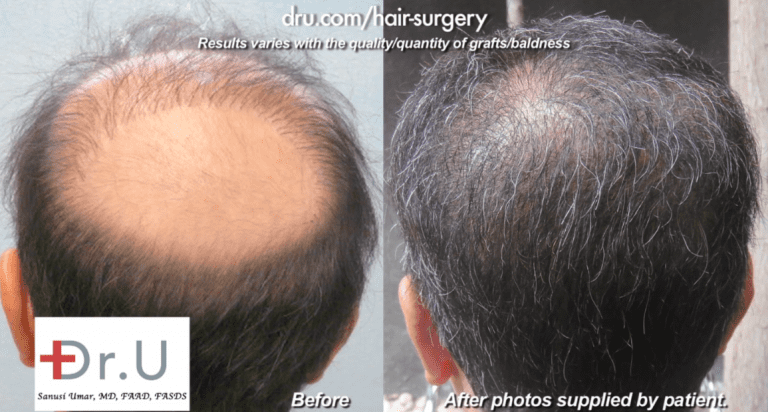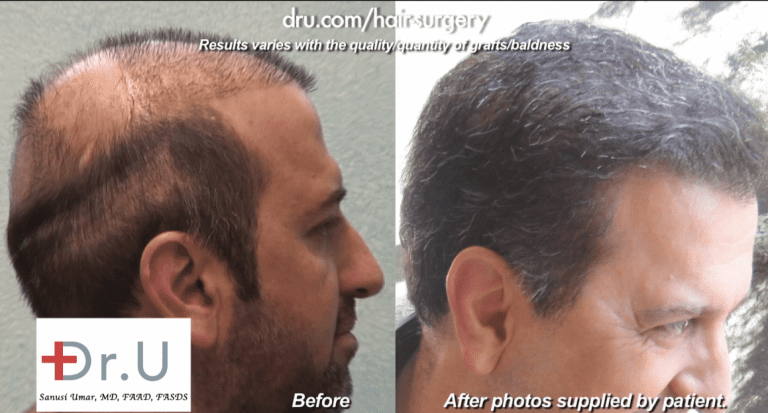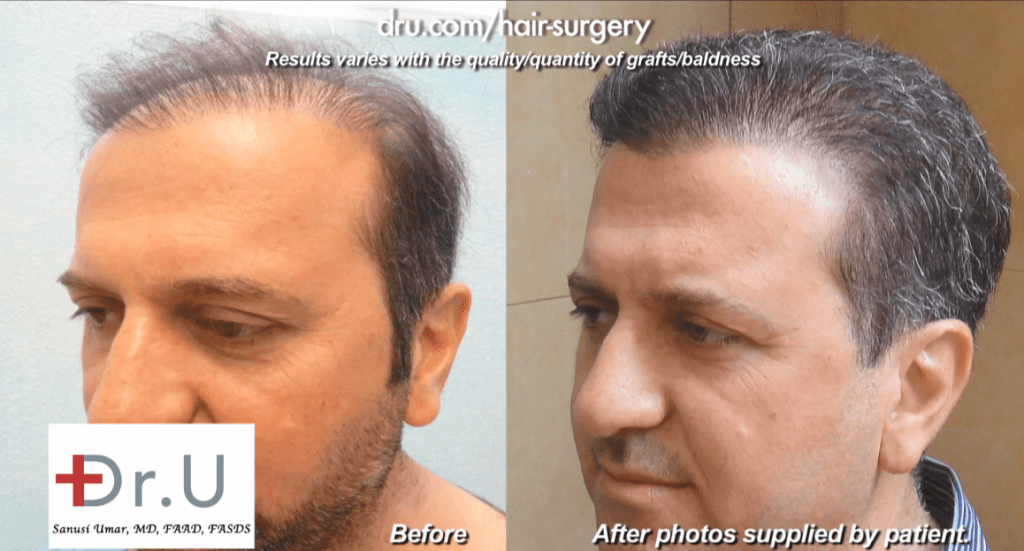Low Growth Yield Following a Hair Transplant: Most patients experience the growth yield they had anticipated without difficulty following a hair transplant procedure. But others wait for the expected 5-6 month timeframe, hoping to see the first signs of new hair, only to realize that their grafts did not grow. And in the end, they must come to terms with disappointing coverage. In this Q&A video, Dr.Umar discusses the causes of low growth yield following a hair transplant procedure.
Article Update July 2022
Things to Watch out for After Your Hair Transplant
In summary, hair transplant results take several months to show full results.
Redness and formation of scabs are expected within the first few weeks, and the present hair shaft will most likely fall within the first 2 months of surgery to make way for new healthy new hair.
Suppose you experience redness or cobblestoning after more than a few months post-surgery. In that case, you should get checked by an experienced dermatologist immediately, as this is a strong indicator of complication.
For more detailed information regarding low growth yield following a hair transplant and what you should expect or consider for a successful hair transplant, continue reading below.
Reason for poor growth after a hair transplant
For more information on Dr. Umar please visit: http://www.dermhairclinic.comLearn more about his specialty in Advanced Follicular Unit Extraction here: http:…
Is Your Progress Aligned With a Normal Hair Transplant Timeline or Poor Hair Transplant Growth
Hair transplant results take time to manifest. And without a basic understanding of the average course of events following a procedure, it becomes easy to mistake the slowness of average growth progress for hair transplant graft failure. Understanding the basic timeline for hair transplant growth will help clarify whether or not a patient should come to terms with the possibility of poor hair transplant yield.
In the first couple of weeks following a hair restoration surgery, patients will notice redness and the formation of scabs which then fall off as the skin heals. Within the first two months after surgery, the hair shafts that were present will also fall out. Many people also mistake this for graft failure. But in truth, this is a very usual and positive sign that new hair is forming.
Signs of new hair sproutings become evident between two and four months. The growth initially looks patchy and even but will start to appear more uniform over time. More desirable-looking results start to manifest between the seventh to tenth months. In some cases, patients may not see the growth even ten months past their surgery. This still is not necessarily an indication of failed grafts. Some late bloomers can achieve the results they want in the end. Dr. Umar recommends that patients wait until month 12 before considering the possibility of poor hair transplant growth.
Causes of Failed Hair Transplant Growth – What Los Angeles Patients Need to Know

Hair implants, or grafts, cannot produce growth if they have been severely damaged. Each follicle is a tiny organ, like the heart or liver. Damage to such structures will impair or even destroy their ability to perform typically.
Many factors can lead to low growth yield following a hair transplant. However, a standard set of causes is still attributed to most cases of low growth following a hair transplant.
Poor Selection of Follicular Unit Grafts
Most patients undergo hair restoration procedures because they suffer from androgenic alopecia. This means that hair loss and thinning are caused by hair follicles that have miniaturized and can no longer produce normal hair as they did before. Those who qualify for hair transplant surgery where the head hair is used will have miniaturized follicles and a supply of non-miniaturized follicles that can produce long-term growth.
Surgeons must be careful to only select grafts that have not been affected by miniaturization. But errors can still happen when it comes to choosing suitable grafts. If miniaturized follicles have been included in the donor pool, patients can have poor growth yield.
Poor Handling of Hair Transplant Grafts
Dr. Umar emphasizes that the extraction and overall handling of the follicles need to be as gentle as possible, avoiding factors that will affect the survival of the graft, such as pulling, tugging, and use of force. Follicular damage due to harsh handling is perhaps the most prominent cause of low growth yield following a hair transplant.

Mechanical Damage From Surgical Instruments
When using general cylindrical Follicular Unit Extraction (FUE) punches, standard forms of damage may be inflicted on the follicular unit grafts. A few examples include:
Punch Misalignment with Hair Follicle Orientation
This damage can occur when the surgeon has to guess the location and positioning of the hair follicle beneath the skin. With the basic FUE punch, they must rely on the visible hair shaft to make these determinations. But it is possible to make inaccurate assumptions and cause damage to the graft by misaligning the punch.
Inaccurate punch alignments may also occur if the patient moves, making it harder to encompass the grafts safely.
Torsional Damage
Torsional injuries may occur when the follicle ascends into the punch lumen and adheres to the internal wall of a rotating punch. The graft becomes stuck and rotates with the punch, as the lower portion is still attached to the skin. This results in breaking the graft.
Lack of depth control
Follicular units, which define individual hair transplant grafts, may consist of more than one hair follicle bundled by a tissue sheath. The ends are often splayed or spread at the lower portion. If the surgeon advances the punch too profoundly, there is the risk of severing these endings.
Impacted grafts
With more expansive follicular units (due to having multiple hair follicles), grafts can become stuck or impacted within the punch’s interior once thoroughly extracted. The surgeon often has to use forceps to retrieve them. When used with excessive force, the graft can become damaged.
Hair Transplant Graft Failure Due to Air Drying and Extended Time Out of Body

The time the grafts spend out of the body must be kept at a minimum. Dr.Umar recommends a maximum span of no more than six hours from when the follicles are extracted until they are implanted into the recipient’s bald regions. This includes the amount of time after they are excised, placed in a fluid storage environment, and retrieved to be placed in the bald or thinning areas.
Since the hair follicles are very tiny structures, small amounts of water loss due to evaporation will have enormously detrimental effects. Once the grafts are removed from their original site, they must be hydrated right away and placed in a chilled aqueous storage medium consisting of physiological fluid.
Also, the time lapses must be minimized after they are removed from their storage environment and inserted into the recipient area. According to Dr. Umar, this should last a few seconds.
Patient Mistakes That Result In No Growth After a Hair Transplant
Hair transplant grafts can also permanently damage a patient’s choices and actions.
The Risks of Wearing a Hair Piece After a Hair Transplant Procedure
Dr. Umar explains that hairpieces can exert an occlusive, frictional effect on the inserted grafts. This may be worsened by adhesives such as tapes and glues, which cause traction and pull on the hair at the skin’s surface. Similar to traction alopecia, when tension is constantly applied to the hair, this may cause tears in the follicle to permanent damage.
The Effects of Chemicals and Inflammation on Hair Transplant Grafts
According to Dr. Umar, patients need to avoid or protect their scalps from anything that might lead to irritation or inflammation of the skin until their hair growth yield has fully manifested.
One example includes harsh chemical products such as dyes, bleaches, and relaxants which can irritate the scalp’s surface. The deeper penetration of these chemicals can harm the grafts. But the effects are often worsened when individuals are allergic to them.
Also, if patients notice the first signs of dandruff following their hair transplantation, they must immediately start following a dandruff care regimen recommended by their doctor. Dandruff is usually caused by a fungus that the body tries to eliminate through inflammatory reactions to attack these microbes. However, these processes can also damage the implanted hair transplant grafts.
Unknown Causes of Poor Growth Yield After a Hair Transplant

In infrequent instances, it is not clear what factors were responsible for failed growth. There are no apparent indications. Or the actual causes may have been outside the range of standard variables described above.
Before choosing a hair transplant provider, patients must understand that these surgeries involve a high degree of skill and experience. The basic premise of these procedures may seem simple enough, as they only involve the transfer of hair follicles from one location to another. But there are many ways for them to face the risk of damage. It would be imperative to select a doctor with a strong track record of successful outcomes in many patient cases.
Following the surgery, the implanted grafts are still vulnerable to being permanently injured or harmed through styling and grooming choices such as using hairpieces and harsh chemicals.
By understanding what causes low growth yield following a hair transplant procedure, patients are in a much stronger position to avoid these factors and experience the results they had planned.
If you are in the Los Angeles area and want to speak to Dr.U about repairing poor hair transplant growth from prior surgeries, submit your information through our complimentary online consultation form.
Reason for poor growth after a hair transplant
For more information on Dr. Umar please visit: http://www.dermhairclinic.comLearn more about his specialty in Advanced Follicular Unit Extraction here: http:…
If you’ve questions about how to prevent low growth yield in the wake of your hair transplant surgery, click the button below. Our Ask Dr. U for allows you to send your inquiry directly to the doctor himself:


